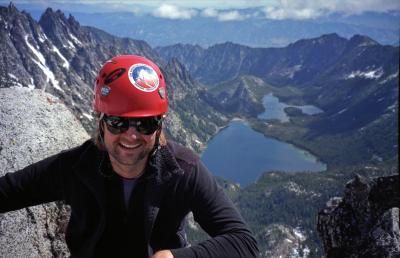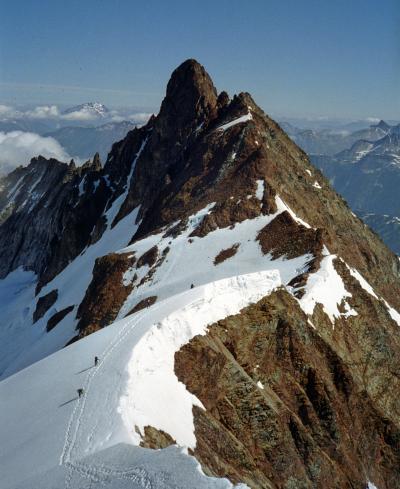January 27, 2005
Mountain man: UW’s Stephenson wants to ease the way for climbers seeking highest peaks
Scott Stephenson would like to take you higher. But unlike Sly and the Family Stone, he doesn’t need any illegal substances to do it. Stephenson and friend Brian Bongiovanni have written a book, Summit Routes: Washington’s 100 Highest Peaks, that they hope will help the average hiker make it to the top of the state’s many mountains. The book debuts this month.
At the UW, Stephenson mostly writes software for Computing & Communications’ Project Consulting Team. But for the last couple of years he’s been out in the mountains every chance he gets, doing research for the book. Last summer, for example, he took a leave of absence so that he could make 15 climbs in less familiar areas. Between them, Stephenson said, he and his co-author have done 80 of the climbs in the book. They got information for the rest from fellow climbers.
The list of peaks in the book isn’t original to Stephenson and Bongiovanni. They got it from the Bulger Climbing Club, a local group that’s built around the goal of climbing these 100 peaks. Stephenson said it’s part of a larger trend among climbers called highpointing — climbing the highest peaks in a defined area, such as the highest one in each of the 50 states.
“In Washington, it’s a challenging goal to accomplish because the state has so much wilderness and it’s so remote and so impenetrable that a lot of the difficulty of the task is not the climb, it’s just figuring out where the peak is, what maps I need, what trails I need to get to these peaks,” Stephenson said. “Really it becomes for each person pursuing this goal a research task.”
That’s probably why only 20 people so far have managed to climb all 100 peaks, a task that Stephenson said takes, on average, about 10 years.
He knows how hard that is, because he’s been pursuing the goal himself. In fact, it was the pursuit of the goal that led him and Bongiovanni, who often climbs with him, to write the book.
“We found ourselves spending so much time on research,” Stephenson said. “Some of these peaks are well known; all you have to do is call the ranger station for help. But a lot of them are much more remote and there isn’t a lot of information about them.”
So, as Stephenson and Bongiovanni accumulated notes, Stephenson began to think about how they could share what they’d learned with other climbers. He thought at first he would do a set of Web pages, but said the material just seemed to “take on a life of its own.” Pretty soon he was shopping the idea around to publishers.
The book is being published by AlpenBooks Press, the publishing arm of AlpenBooks, a local distributor of books about the outdoors. Stephenson says the book’s organization is unique. Rather than do a segment on each peak, listing several routes to get to the top, it’s organized geographically in groups of peaks.
“So you can make one hike in and set up camp once, then spend a day or two climbing peaks radiating out from that central camp,” he explained. “In the book we call those trips slams. And in almost all cases we give only one route up each peak — the easiest route. We’re trying to make it accessible to as many people as possible.”
There’s also an appendix that groups climbs by skill level and by time required.
For Stephenson, the book is really the culmination of a lifelong interest in the outdoors. He grew up in an athletic family who did canoeing, sea kayaking, skiing and hiking together. Stephenson went on his first climbing adventure with an older brother and fell in love with the sport “because it allowed me to get higher and see these incredible views.”
He became so enthralled, in fact, that he moved to San Francisco from his native Wisconsin primarily for the chance to climb in the Sierras. And it was the lure of the Cascades that brought him to Seattle.
But Stephenson isn’t such a climbing enthusiast that he has forgotten the average hiker. He emphasized that 15 of the climbs in the book are totally non-technical and can be done by people with no climbing experience. An additional 50 are called scrambles, meaning they don’t require ropes, but there will be times when you need to climb over boulders or use your hands to pull yourself up. Only 35 are just for experienced climbers.
Of the more familiar peaks, Rainier is Stephenson’s favorite. “When you set foot on Rainier, you just feel tiny,” he said. “You see it from the city and it’s big, but when you’re on it, it’s like, ‘Oh my God, this thing is enormous.’ It’s such a dynamic environment.”
Stephenson said he chooses Mount Shuksan, in the North Cascades, as his favorite of the lesser-known climbs, and described it as looking “like something out of the Alps — a very rugged, chiseled mountain with huge glaciers.”
But no matter where he goes, Stephenson considers climbing essential to his mental health. “If I go a week or two without being in the mountains, I start getting agitated,” he said. “When I go out in the mountains, I feel that any distractions or stress in my life is instantly gone. I step out there and I’m so focused on what I’m doing and the environment around me and my place in the environment that I forget about everything else.”
The book is currently available on the Web through http://www.trailstuff.com and http://www.tamassee.com, and is also sold in the Mountaineers Bookstore and all local REI stores. For more information, go to http://www.summitroutes.com.




